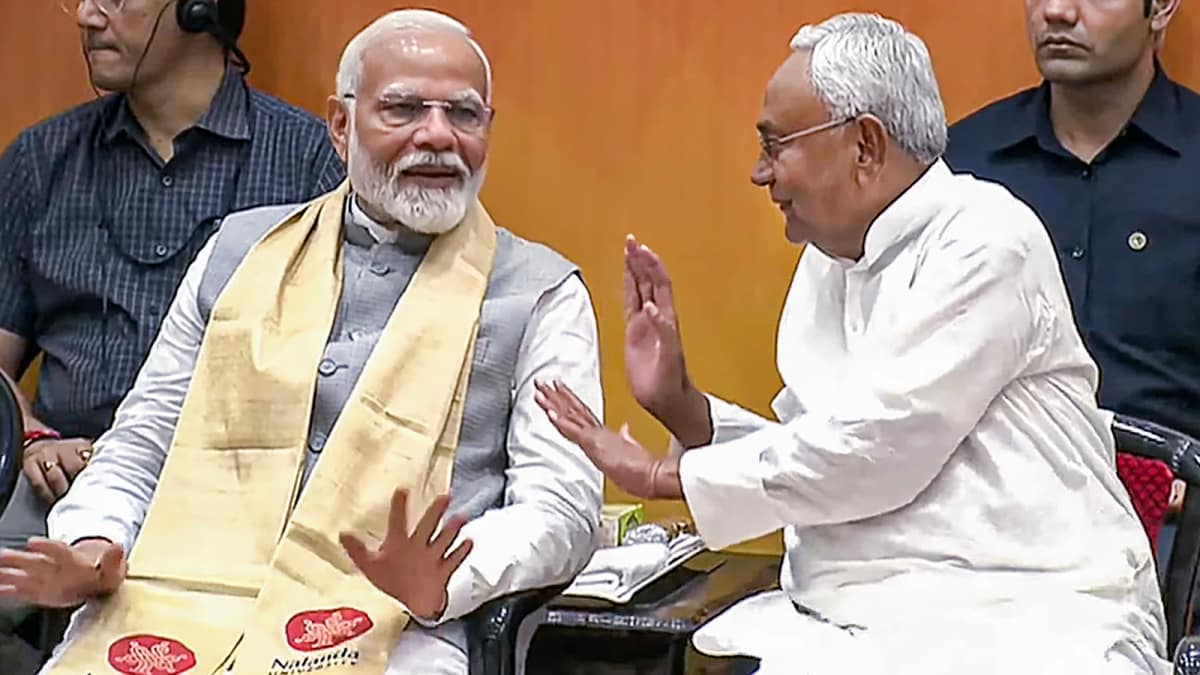Last Updated:
With alliances shifting and the stakes higher than ever, Nitish Kumar’s journey reflects the unpredictability of Bihar’s politics—where loyalties are tested, but survival remains the ultimate goal
Nitish soon realised that the INDIA bloc was unlikely to succeed due to a lack of consensus on a common leader to challenge Modi. (File image: PTI)
Though the National Democratic Alliance has been a relatively strong coalition at the Centre, the same cannot be said for Bihar. Recently, Nitish Kumar’s frequent U-turns have contributed to this instability, but the saga began with the Mausam Vaigyanik (weather expert) of Indian politics, Ram Vilas Paswan. Other leaders like Upendra Kushwaha, Mukesh Sahni, and Jitan Ram Manjhi also consistently changed sides during Nitish Kumar’s journey.
Having said that, if the political alliances are clearly defined before the elections and the public knows who is with whom, it becomes easier for voters to pick the side they prefer. But imagine the situation when a friend-turned-foe decides to challenge one of the alliance partners while praising the other. This is exactly what Narendra Modi’s “Hanuman”, Chirag Paswan, did in the 2020 elections.
Chirag Paswan’s role in the 2020 polls
Riding on the sympathy wave after the death of his father, Ram Vilas Paswan, the young firebrand Chirag targeted Nitish Kumar and openly declared Modi as the revered leader of the nation. When the results were announced, Chirag was left with only one seat, but he succeeded in jolting Nitish, whose tally crashed to 43—the lowest since he formed an alliance with the BJP in 2005. Chirag celebrated the outcome, as his candidates ensured the defeat of Janata Dal (United) in over 20 assembly segments.
Chirag Paswan’s campaign successfully sowed discontent among BJP supporters toward Nitish Kumar. The election followed Nitish’s second U-turn in 2017 when he broke ties with the Rashtriya Janata Dal and returned to BJP’s fold. BJP’s core voters were unhappy with Nitish, and they didn’t come out in full support wherever JD(U) contested. Instead, they found an alternative in the LJP, whose leader was openly praising their leader. Nitish carried a grudge, which set the stage for his third U-turn in August 2022 when he parted ways with the BJP and formed a government with Tejashwi Yadav.
Nitish Kumar’s changing political allegiances
Known as a master of political manoeuvring, Nitish Kumar briefly tried to unite the opposition against Narendra Modi and played a key role in forming the INDIA bloc. However, Tejashwi Yadav continuously pushed him for a role in Delhi, echoing the actions of his father, Lalu Prasad Yadav, when Nitish first snapped ties with the BJP in 2013, opposing Modi as the prime ministerial candidate. On the other hand, Nitish kept Tejashwi happy with random statements like, “The time has come for youngsters to take over.”
But Nitish soon realised that the INDIA bloc was unlikely to succeed due to a lack of consensus on a common leader to challenge Modi. After one such meeting in Delhi, Nitish changed his stance and decided to take another U-turn to reunite with the BJP. A leader who had vowed, “Mar jaana qabool hai lekin unke (BJP) saath ab nahi jayenge” (Death is acceptable, but I will not go with BJP), was now seen taking another pledge: “Galti ho gayi, ab kabhi kahin nahi jayenge” (I made a mistake, and now I will never change sides). Now, he never forgets to repeat this from every podium.
Ninth term and the voter’s dilemma
Nitish Kumar took oath as chief minister for the ninth time last year. However, the process did not require an election, which again did not sit well with BJP voters in Bihar. The situation mirrors that of the 2020 elections but with one significant difference—Chirag is firmly behind Nitish. Manjhi and Kushwaha are also in the fold. But what about the voters?
While NDA leaders are united, the same cannot be said for their voters. Nitish knows that he barely won the last election when his popularity as “Sushasan Babu” (good governance man) and trusted partner of the BJP was waning. As he faces what may be his last electoral battle later this year, Nitish is aware of the daunting task of maintaining his relevance.
JD(U)’s strategy for the upcoming elections
JD(U) national president and Rajya Sabha member Sanjay Jha, along with other senior leaders, has been strategically working on a series of activities leading up to the assembly elections to bolster Nitish Kumar’s image. One thing is certain—Nitish will be the CM face of the NDA. The BJP has openly endorsed him after the unexpected Lok Sabha results reaffirmed Nitish’s importance in Bihar. However, Maharashtra now serves as a reference point for similar discussions. BJP leaders still feel that if their party wins more seats, the CM face could change.
The JD(U) leadership is well aware of this possibility. But it refrains from making this public. Instead, senior JD(U) leaders chalked out a plan to overhaul the image of their leader and ensure BJP cadres do not betray him at the hustings. Planning for this started on October 28 last year when Nitish called state and district presidents and other leaders of all NDA partners to his residence. Sanjay Jha outlined the plan, which was endorsed by Samrat Chaudhary.
Building unity among workers
The planning soon took on a new dimension. Sanjay Jha, playing the role of George Fernandes by reaching out to BJP leaders and smaller allies, successfully convinced everyone that if the NDA wanted to win 225 out of 243 seats, the workers at the grassroots level must feel united. “We can’t afford any misgivings on the ground. Whether JD(U) or BJP, the workers need to communicate and act together,” Jha stated.
Based on this, a mega plan was devised in December, which included joint workers’ conferences in all 37 districts, where state presidents of all five NDA partners would be present. The first phase of this campaign started on January 15 in West Champaran, covering 10 districts. Currently, the fourth phase of this conference is underway, covering Khagaria and Begusarai. According to Jha, the last phase is expected to be completed before the budget session of the Bihar assembly, which begins on February 28.
Nitish’s Pragati Yatra
Alongside this, Nitish Kumar embarked on a state-wide yatra called the Pragati Yatra, which is now in full swing. Sanjay Jha said, “Nitish Kumar’s image is that of a leader who pulled the state out of the dark age of the Lalu era. Nitish ji is not just narrating what he has done for the people but also taking stock of current development works and outlining what needs to be done in a given district.” The development projects, such as foot overbridges, roads, and nallahs, are getting instant approvals, and the yatra has become a platform to showcase Nitish’s achievements.
With alliances shifting and the stakes higher than ever, Nitish Kumar’s journey reflects the unpredictability of Bihar’s politics—where loyalties are tested, but survival remains the ultimate goal.








